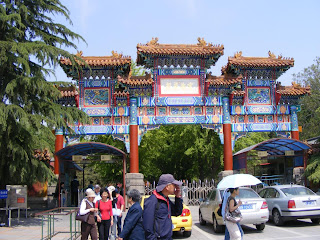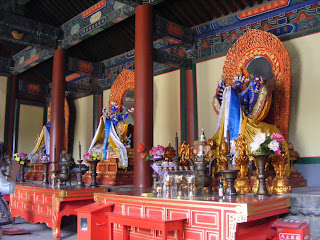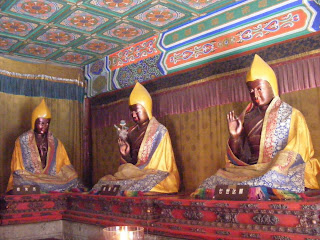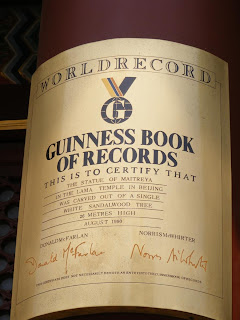Yonghe-Gong sau Templul Lamaist este una dintre cele mai frumoase constructii istorice pe care am vazut-o in Beijing. La inceput, pe acest teritoriu, in timpul dinastiei Qin (1368-1644) se afla un birou al eunucilor de la palat. Mai tarziu, in 1694, in timpul dinastiei Qing, s-a construit apoi o resedinta pentru printul Yin Zhen. Dupa ce acesta a devenit imparat, s-a dat constructiei destinatia de templu, conform traditiei. In anul 1744 a devenit lamaserie, aici gasind adapost calugari budisti tibetani din Mongolia si Tibet. Odata cu declararea Republicii Populare Chineze templul a fost inchis si cladirile declarate monument national. Astfel a supravietuit urmarilor nefaste ale revolutiei culturale chineze. A fost redeschis pentru public in 1981.
Templul Lama este un loc viu, plin de oameni, de credinciosi nu de turisti, care vin aici sa aduca ofrande zeilor lor si sa se roage.
In templu se patrunde, dupa ce ti-ai luat bilet, printr-o frumoasa poarta pictata (pailou) si apoi se trece, rand pe rand, de la o sala la alta, prin cele 5 sali principale. Salile laterale servesc diferitelor scopuri ale calugarilor. La intrare strajuieste un frumos leu de piatra. Constructiile au elemente de arhitectura han, manchu, mongol si tibetana.
Se poate ajunge la Templul lamaist de la statia de metrou Yonghe Gong. Biletul de intrare costa 25 RMB, adica sub 3 euro si include si un mic DVD, cu templul.
Dupa ce treci si de poarta Yonghe, care dateaza din 1696, incepi sa admiri frumoasa arhitectura exterioara a salilor si pavilioanelor, a acoperisurilor frumos ornamentate.
Miroase a betisoare parfumate, oferite in manunchi ca ofranda pentru zei si arse in frumoasele arzatoare din fata salilor, datand din secolul al XVIII-lea. Prin curti trec calugari, vazandu-si de treburile lor sau oprindu-se sa stea de vorba cu cate un credincios.
Intram si in sali si ne uitam la zeii care accepta ofrandele si rugaciunile oamenilor si zambesc misterios, nelasand sa se vada daca le vor implini sau nu. Tavanele casetate si ornamentate ne uimesc prin bogatia desenelor.
In Falun Dian sau Sala cu Roata Legii se afla o statuie de bronz a lui Tsong Kapa, de 6 m inaltime. Acesta este fondatorul sectei Palariilor Galbene din budismul tibetan.
Parcurgem rand pe rand salile, oprindu-ne in curtile interioare sa vedem diverse obiecte de cult din budismul tibetan.
Ne apropiem de ultima sala, Wanfu Ge adica Turnul celor 10000 de Fericiri. Aici este adapostita o statuie Maitreya (viitorul Buddha) de 26 m inaltime (din care 8m sunt ingropati in pamant), facuta dintr-o singura bucata de lemn de santal alb tibetan. Acesta este un dar al celui de-al 7-lea Dalai Lama, pentru imparatul Qianlong. Transportarea sa la Beijing a durat 3 ani. La intrare, un insemn ne indica ca statuia este inscrisa in Cartea Recordurilor Guinness. Este prima oara cand am vazut o statuie religioasa atat de mare, care te zdrobeste pur si simplu. La picioarele ei, oamenii se rugau dar ea privea departe, deasupra lor si a grijilor si spaimelor lor omenesti.
Daca ajungeti la Beijing, va recomand cu toata caldura sa vizitati acest templu pentru ca merita cu prisosinta.
There are 5 big halls here, dedicated to different deities. The temple is dominated by colours, by the smell of incense and people’s prayers. Beautiful burners may be seen in the courtyards, along with different other cult objects.
In the Falun Dian Hall a 6 m tall statue of Tsong Kapa may be seen. He was the founder of the Yellow Hats sect of Tibetan Buddhism. In the last hall, Wanfu Ge or The Tower of 10000 Hapinesses, a Guiness record: a 26 m tall statue of Maitreya (the future Buddha) carved in a single Tibetan white sandal wood. It is the wealth and the proud of the temple.You may reach the Lama Temple from the Yonghe Gong metro station. The entrance fee is a little less than 3 euros, a small DVD included in the price.































I know the feeling now of looking at things so beautiful it will make you cry. Staring at your photos made me feel that.
Your images are so fantastic. You captured amazingly the details of the places you visited. I feel like I’m there. Thanks for this experience.
Beautiful temple, very colorful.
Beijing is beautiful. it’s great to get a taste of its intriguing culture and history. love the ornate roof details.
Foarte interesant! Nu am vazut pana acum un templu budist in realitate, dar mi-ar placea foarte mult.
Thank you very much, Rizalenio for your warm remarks. Lama Temple is the most beautiful temple I have seen in Beijing.
Rajesh, thank you for reading my blog.
Life Ramblings, I do not have the opportunity to visit Tibet and I knew that visiting Lama Temple it will be as close as I may feel doing this. It is an amazing place.
VertaAnge, si pentru mine a fost o prima experienta de acest gen, de aceea am si facut atat de multe fotografii.
Gorgeous! It’s a bit sorry that China uses as a tourist attraction something that it has almost destroyed with its attitude toward Tibet.
I can’t agree more, VP!
I totally agree with VP, but the place is fabulous!
Have anice Friday:)
Thanks, Joo, you too! I also agree with VP on this issue.
Being a Chinese who goes to the temple quite often, I still like those in China!
The one I really like most is the hint of the monk reading and sitting just inside the doors…
Enjoyed them all..
It’s one of my favourits too, Wong! It’s so meaningful!
The problem with those trips is that wanting to see more, one is always in a hurry in a way, and so one losts the opportunity “to hunt” for such images. Especially when you are part of a group (it was not the case here), you have to look very quickly around in order to find your subjects. And, of course, you do not want to loose the explanations 🙂
ati fost la multe temple frumoase, sper sa pot ajunge si eu din nou acolo, fiindca desi am stat destul de mult in |China am vazut f putine…